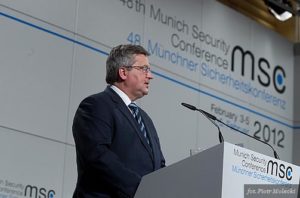
President of Poland Bronisław Komorowski at the 2012 Munich Security Conference (source: www.prezydent.pl)
In recent months the EU security policy jargon has been filled up with catchy buzzwords, such as ‘permanent operational headquarters’ or ‘pooling and sharing.’ Some experts even coined the latter into an ironic phrase: “you pool, we share,” which to some extent reflects both the discrepancies between the standpoints of the EU states and the challenges for the Common Security and Defense Policy (CSDP). Be it as it may, these two aspects will be crucial for the future of effective common European defense and external operational engagement. However, there is one more buzzword which still has not been fully rediscovered, although it will be of even greater importance: a new strategy.
Until recently, an update of the 2003 European Security Strategy (ESS) was a political no-go zone. After a partial failure of the ESS amending endeavor in 2008, when the EU Member States ended up in agreeing upon a report on the implementation of the ESS, a clear lack of political will pervaded the region. One of the arguments suggested that European governments may be suffering from ‘strategic fatigue.’ Indeed, we have waited for almost four years to get back on the political track. Finally, during the recent Munich Security Conference (February 3-5, 2012) Bronisław Komorowski, the President of the Republic of Poland, voiced his concerns about the future of European security and called on the European leaders to return to the idea of a new security strategy for the European Union. This means that after its successful Presidency of the EU Council Poland is ready to pursue a bigger reform of CSDP. In this context, three questions are crucial. First, why do we need a new ESS? Second, when is the right time to amend it? Third, how should this process be conducted?
1. Why?
Our entire strategic environment is undergoing significant evolution. Change is occurring worldwide. These observations generate a sense that Europe is falling behind. As the strategic centre of gravity is shifting towards Asia, with China and India gaining increasingly in importance, the U.S. clearly wants the EU to take on more responsibility for the continent and its neighborhood. The EU must, therefore, show relevance in its own neighborhood if it is to be taken seriously on the global scale. Moreover, even if the threat analysis of the 2003 ESS is still worryingly valid, the parameters have changed – security has become network-centric. In fact, Europe is in need of updated assessments of the phenomena of migrations and their consequences, terrorism, cyber security, the security of trade routes, energy security or the rivalry for natural resources. Furthermore, a collapsing European economy has been presenting one of the most fundamental security threats discussed thus far. Admittedly the 2003 ESS tells the EU to do things in holistic, preventive and multilateral ways, but does not provide a proposition what to do. Although the ESS was written with wit and sensibility, its lack of priorities is a problem that needs to be fixed.
2. When?
What one can sometimes hear in Europe is that currently there is no opportunity for a new strategy. It is claimed by some that we should rather wait and fully implement the current ESS. For others, the strategy-making is distracting and, therefore, it would only reduce our ability to grapple with the current crisis. In fact, both statements are fundamentally wrong as they either turn a blind eye to a new strategic reality or assume that no lessons have been learned from the crisis yet. Why the time is right to launch a strategic review in 2012? Two reasons prevail. Firstly, we are gearing up for a new round of budgetary negotiations, scheduled for completion in 2013. And now would be the opportune time to have a revised ESS in hand, so that the EU’s new 2014-2020 budget could match its new ambitions. Secondly, the post-Lisbon institutional architecture, especially the European External Action Service (EEAS), needs a strong strategic guidance. The EEAS structure will be revised for the first time in 2013. Therefore, a new ESS could become a guidebook for the next phase of its development.
3. How?
This is the toughest question to answer. Nonetheless, two aspects will be crucial – leadership and public diplomacy. Therefore, it is advisable to use positive experiences from the work on developing the latest NATO Strategic Concept. The NATO procedure included a Wise Men Group tasked with producing a blueprint to facilitate the drafting process as well as the deliberations. Moreover, NATO devoted significant resources to public events aiming the strategic review process at wider public and societal actors. This is the pattern that the EU should follow. Therefore, the ESS review process could start with the establishment by the High Representative of a Wise Men Group that would prepare an initial text. Subsequently on its basis a draft ESS could be prepared by a small task force representing both EU institutions and the Member States. Without these clear guidelines we might end up facing the risks of lacking political consensus and a clear mandate.
The opinions, findings and conclusions expressed herein are those of the author and do not necessarily reflect those of the National Security Bureau of the Republic of Poland.